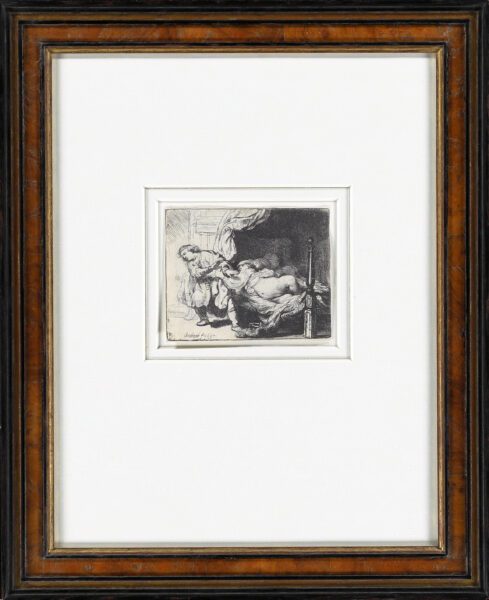“Joseph and Potiphar’s Wife”, 1634
etching 90 x 115 mm; with wide margins top and bottom;
signed and dated ‘Rembrandt f.1634’
"*" indicates required fields
Notes
Dutch Baroque artist Rembrandt van Rijn (1606-1669) is one of the most celebrated artists in the canon of Western art. A prolific painter, Rembrandt was also a draftsman and printmaker of formidable skill. He began experimenting with various etching techniques in the 1620’s and by the 1640’s had revolutionized the way in which light and shade were represented in etchings through his use of chiaroscuro. Although chiaroscuro (the juxtaposition between light and dark which is utilized to enhance composition and form) was popular amongst painters, it was seldom used to the same effect and technical mastery in etchings until Rembrandt. Thus, he was held in great esteem throughout Europe in his lifetime and was considered a master printmaker. His prints were also an important source of income for him. Unlike many artists of the time, who made drawings for prints and employed a professional printmaker to create prints after the drawings, Rembrandt’s talent for printmaking meant that he created all his own prints, ensuring greater profit upon sale.
In this print, entitled Joseph and Potiphar’s Wife (1634), Rembrandt has portrayed an Old Testament biblical scene from Genesis 39, in which Potiphar’s wife unsuccessfully attempts to seduce her husband’s slave, Joseph. In the heat of the moment, Joseph has to decide whether to offend the wife or betray her husband, his master, and after a physical tussle he flees the house.
What really sets this print apart from other artists’ and writers’ representations of the same theme is that Rembrandt seems to have attempted to portray the conflict and emotional confusion experienced by Joseph in his rejection of Potiphar’s wife. Most other artists might shy away from depicting the temptation that Joseph attempts to resist, instead choosing to depict him as stoic and unaffected by the advances of Potiphar’s wife. However, Joseph’s deeply human turmoil is portrayed poignantly by Rembrandt.
From a purely visual perspective, although small in size, the print is also highly dynamic in its representation of an ephemeral moment. The print captures the exact moment in which Joseph’s half-naked wife lies on a bed and pulls Joseph towards her. Adding to the dynamism of the print is the disheveled bedding and the women’s haphazardly pulled up nightgown. Rembrandt’s use of chiaroscuro not only adds form and depth to the work, but also symbolically casts the unfaithful wife into the shadow, giving the four-poster bed a foreboding, cavernous atmosphere.
Rembrandt was raised as a member of the Dutch Reformed Church. Despite Rembrandt’s Protestantism, he frequently depicted scenes from the Old Testament, and was known to be sympathetic to Judaism. He lived in the Jewish quarter of Amsterdam and was good friends with a rabbi, Menasseh ben Israel. It was not until the 1650s that Rembrandt’s exploration of Old Testament themes was at its most constructive. This was also the period in which he painted several scenes from Genesis 39, including Joseph Resists Temptation (1655) and Joseph Accused by Potiphar’s Wife (1655), however, no other etchings depicting this theme are known, and certainly none are as graphic as Joseph and Potiphar’s Wife (Hinterding, 1993 – 1994).
This makes this particular print an early example of Rembrandt’s portrayal of scenes especially pertinent to Jewish history, which was to become an important facet of his oeuvre. When combined with the sexual nature of the print, and its dynamic depictions of fraught emotion, this etching is a key example of Rembrandt’s mastery of the medium, both technically and in terms of his conceptual treatment of subject matter.
Literature
Bartsch 39; Hind 118;
‘The New Hollstein’, 2013, no. 128, first state (of five)
Plate in existence, Rembrandthuis – with Nowell-Usticke(1967): C
Provenance
- Formerly in the collection of the Rijksprentenkabinet, as a double (see stamp R.P.K.L.-Rijks Prenten Kabinet Leiden). In 1886 it was decided to sell the double and use the proceeds towards the purchase of a historical atlas;
- Douwes Fine Art, Amsterdam, 2018
- private collection, The Netherlands
Literature about the artist:
Hinterding, E., ‘The History of Rembrandt’s Copperplates, with a Catalogue of Those That Survive’, Simiolus, Vol. 22, No. 4 (1993-1994), pp. 253-315.





